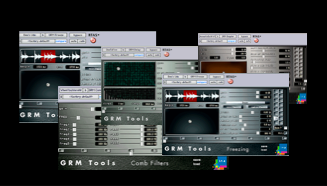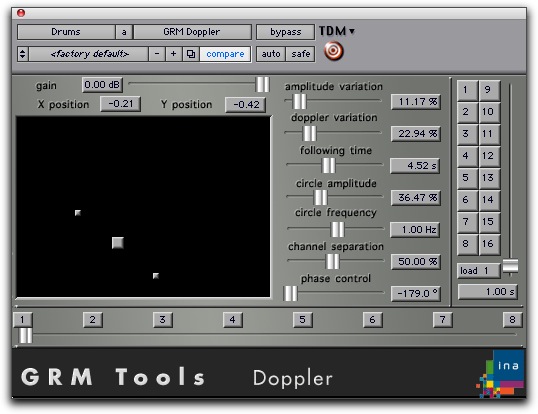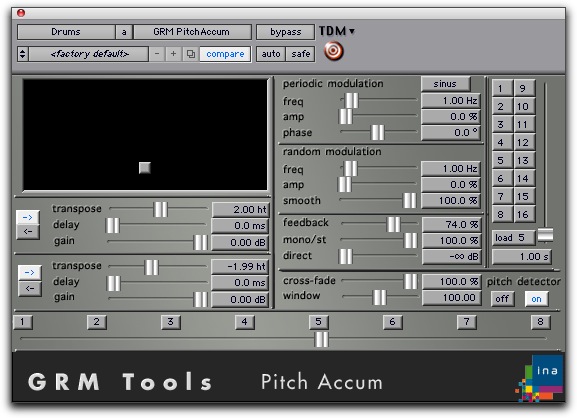GRM Tools, plugins used by many sound designers out there. They had an article about Dane A. Davis featuring his company Danetracks. He spoke about the plugins that he use and some techniques or procedures with the processes. Even if you don’t GRM Tools, be sure to read, the article deals all kinds of interesting techniques.
Did you see the freeway chase scene in The Matrix: Reloaded? Or that gigantic sky crane helicopter in Swordfish? How about those nifty spaceships in Treasure Planet and the otherworldly screams and grinding gears in 13 Ghosts?
If you’re into movies as much as you’re into sound and you stick around for the credits, then you already know about the signature Academy Award-winning touch of Danetracks Studios. Every sound effect in Romeo Must Die, 8 Mile, and The Matrix trilogy — including The Matrix: Revolutions — was scored there. The passion for audio at this West Hollywood, California, sound design, editorial, and mixing company is matched only by the team’s boundless energy for improvisation.
Jamming On Sound Design
“We are heavily into experimentation with GRM Tools here,” says Danetracks owner and sound designer Dane Davis. “We play around a lot with the plug-ins to come up with different textures. Just throwing the simplest sound into Doppler, Pitch Accum or Shuffling gives us the ideas we need to derive things in unique and completely different ways.”
The Danetracks crew leaves no idea unturned when it comes to creating, recording, and building new sounds for film. They gather and record tons of original field content for every movie in order to remain unique. If a scene calls for mechanized sounds, for instance, they go out and find dozens of gears and levers to hand build their own apparatuses before instantiating GRM Tools in their Pro Tools systems back home.
“The depth of what you can do with all the GRM plug-ins is amazing,” says Richard Adrian, another sound creator par excellence at Danetracks. “There are so many different parameters that every time I use GRM Tools I find something new. It’s best to have as many sound design tools as possible, but these are the most useful tools that we have in our plug-in library.”
“The more tools the merrier,” Davis agrees. Danetracks team member Michael Johnson, who used the ST Bundle plug-ins extensively on The Matrix: Reloaded and The Matrix: Revolutions, feels the same way. “We couldn’t have done Revolutions without the ST plug-ins,” says Johnson.
The Tao and Doppler of Neo’s Matrix
Regardless of the movie, the goal of every Danetracks effect is to make every sound appear to have originated in a real acoustic Earth space. Their collective approach is to stay far away from static, synthetic sounds that sit motionless in a dry environment.
“We use Doppler constantly to counteract that quality,” Davis continues. “We use it for creating a liveliness to sound by adding a subtle, natural motion to things. I use it upstream from a lot of chains of plugins just to give it a little bit more shimmer, you know, a sort of ‘microphone realness’ quality in an acoustic space. We also do a lot of specific things, as well, such as the helicopter carrying a bus through downtown L.A. in Swordfish. 90 percent of that scene was created using Doppler with various wind and other natural sounds to create the swirling character of the blade wash from that gigantic machine.”
“The real helicopter in that scene sounded like a big vacuum cleaner,” laughs Adrian. “Doppler is extremely useful, especially when used subtly when we need just a little movement from things. It just gives the sounds more motion and far more of an interesting quality. A generic doppler effect is easy to recognize when applied liberally, but it’s better to go much more subtle with Doppler. Nobody will ever know you used a plug-in to make a sound come off as if it was a naturally recorded effect.”
The opening scene of Swordfish features the sound of a ton of ball bearing elements. Davis used an array of four microphones to capture the feel of motion in all those bearings bouncing about, but that wasn’t enough reality. He used Doppler here to further stretch out the sound of the motion of the bearings.
Adrian, who also worked on Swordfish, Matrix, and 13 Ghosts, explains some of his technique when working often with Doppler. “I used to use the circle frequency to let the circles go and create my doppler effect; you know, just put it in loop record and get several variations on Doppler. But now I do it all by hand. I put the circle amplitude to zero and loop it all by hand because there’s a lot more control that way.”
Shuffling Ghosts & Better Gears With Pitch Accum
The Danetracks team is also big on using the GRM Tools Shuffling plug-in to place sound elements into a more realistic setting. Again, they stress the subtle, intutitive use of this tool to enhance a sound’s stereo image and to make it sound more interesting. But what about all the cool granular distorted delays and other effects they can also create with Shuffling?
“Sometimes. Like some of the ghost things we did where we took screams and shuffled them around,” Davis recalls about working on 13 Ghosts. “We used Shuffling there to randomize those screams and for creating those ‘data burst’ sorts of sounds in The Matrix and other films we’ve worked on. Shuffling can produce a kind of very metric, almost musically-synthetic sound which we shy away from here. But I know people using it pretty heavily for that sort of groove making type of thing.”
“There’s all kinds of interesting things you can do with Shuffling,” Adrian agrees. “Shuffle it and then reverse it and you get this nice lead-in to certain things. But when I need to make something sound a lot bigger than it actually is, I always use Pitch Accum. In 13 Ghosts, for instance, the entire house is made of glass and metal and there are these giant gears everywhere.”
Giant gears and ghosts?
“Yeah, we just built and recorded various little gears,” he continues. “But in order to get that giant sound I ran it through Shuffling and Pitch Accum. There’s a certain recipe I have for using those plug-ins that makes everything sound much, much bigger.”
“That’s a very effective way of working,” says Davis. “It creates a totally different quality than just generating sub-octaves in a real-time harmonizer type of approach. Pitch Accum definitley gives you a different sort of grainy quality that’s very nice.”
Working subtly with the entire GRM Tools set is a Danetracks specialty. They’ll delve into more “obvious” sounds if that’s what a scene calls for, but using the plug-in suite in unique and creatively stimulating ways are a house speciality. Especially for Dane Davis.
“Now, I’m also a very dedicated mis-user of tools,” admits Davis. “I always did that with outboard boxes and I do the same with the GRM Tools plug-ins. I try to find things to do that they’re not supposed to do. I’ll place them upstream, sometimes downstream from other processors just for the slightest little movement. I’ll look at what they’re doing and it might be evolving very, very slowly, but if I bypass it, it just completely shifts the sum sound into a less natural kind of state. I love that kind of subtlety. The GRM Tools are enormously flexible. By shifting around what appears to be the harmonics of a sound, it makes it seem as if it is something real out there in the real world.”



This was really interesting, I must look into GRM Tools a bit more now :)
Nice, article been using the GRM plug-ins for years. I still use them all the time, they can do amazing things. Everyone should check them out. RD
Yes! My favourites are Delays and undoubtedly Doppler. The entire package is awesome!
Great article, I enjoyed reading it, gave me a few ideas.
GRM tools are my favourite plugins for Sound Design, to be honest they are in a league of their own.